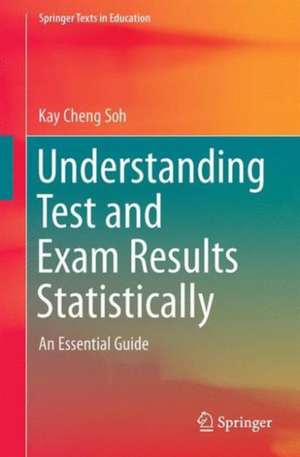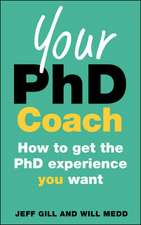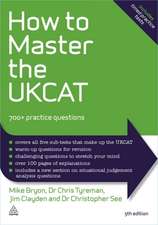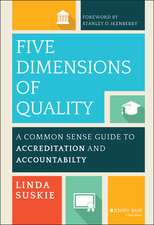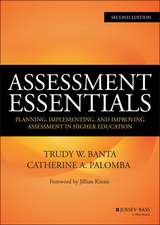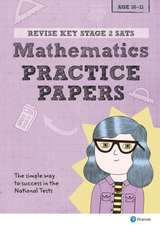Understanding Test and Exam Results Statistically: An Essential Guide for Teachers and School Leaders: Springer Texts in Education
Autor Kaycheng Sohen Limba Engleză Paperback – 19 aug 2016
“The strongest aspect of the work or author’s view is that the author can put himself in the shoes of teachers and make the work a very practical guide for teachers and school leaders. As a very experienced educator and researcher, the author knows very well about the knowledge skills that are essential for the professional development of teachers. He is able to explain the statistical and measurement concepts in plain language and with examples that are highly relevant to the target audience. In addition, the author also conveyed an important message to the target audience throughout the work… by pointing out the mistakes and misunderstandings of the interpretation of test scores and measurement design. The author reminds the audience about the importance of proper use of tests and test scores when teachers and school leaders make any education decisions, which has much implication on the professional integrity of teachers and school leaders.”
Dr. Joyce Kwan, The Education University of Hong Kong, Hong Kong
“This book covers all the statistical tools for analyzing educational data and provides examples to explain the ideas. Chapters 10-17 are practical data analysis in educational data that helps readers have a better understanding of the procedure to analyze the data.”
Dr. Alpha Ling, The Education University of Hong Kong, Hong Kong
“It looks like a very interesting book with attractive topics and practical problems in educational statistics. Though the topics remind me of the classic book How to Lie with Statistics, this book aims at preventing and correcting statistical misconceptions in educational context.”
Dr. Zhu Ying, National Institute of Education, Nanyang Technological University, Singapore
Din seria Springer Texts in Education
- 17%
 Preț: 458.71 lei
Preț: 458.71 lei -
 Preț: 362.31 lei
Preț: 362.31 lei - 17%
 Preț: 524.90 lei
Preț: 524.90 lei - 17%
 Preț: 465.82 lei
Preț: 465.82 lei -
 Preț: 223.99 lei
Preț: 223.99 lei -
 Preț: 397.27 lei
Preț: 397.27 lei - 13%
 Preț: 448.22 lei
Preț: 448.22 lei - 17%
 Preț: 362.70 lei
Preț: 362.70 lei - 17%
 Preț: 426.76 lei
Preț: 426.76 lei - 17%
 Preț: 426.16 lei
Preț: 426.16 lei - 15%
 Preț: 461.73 lei
Preț: 461.73 lei - 17%
 Preț: 361.52 lei
Preț: 361.52 lei - 17%
 Preț: 394.34 lei
Preț: 394.34 lei - 17%
 Preț: 360.93 lei
Preț: 360.93 lei - 17%
 Preț: 457.35 lei
Preț: 457.35 lei - 17%
 Preț: 526.00 lei
Preț: 526.00 lei -
 Preț: 444.94 lei
Preț: 444.94 lei - 15%
 Preț: 467.79 lei
Preț: 467.79 lei -
 Preț: 484.30 lei
Preț: 484.30 lei - 15%
 Preț: 582.80 lei
Preț: 582.80 lei - 15%
 Preț: 493.37 lei
Preț: 493.37 lei - 15%
 Preț: 578.37 lei
Preț: 578.37 lei -
 Preț: 449.15 lei
Preț: 449.15 lei - 15%
 Preț: 500.26 lei
Preț: 500.26 lei - 15%
 Preț: 587.02 lei
Preț: 587.02 lei - 15%
 Preț: 579.34 lei
Preț: 579.34 lei - 15%
 Preț: 537.65 lei
Preț: 537.65 lei - 15%
 Preț: 694.37 lei
Preț: 694.37 lei -
 Preț: 392.97 lei
Preț: 392.97 lei -
 Preț: 487.57 lei
Preț: 487.57 lei -
 Preț: 500.46 lei
Preț: 500.46 lei - 15%
 Preț: 538.93 lei
Preț: 538.93 lei - 15%
 Preț: 592.77 lei
Preț: 592.77 lei - 15%
 Preț: 464.18 lei
Preț: 464.18 lei - 15%
 Preț: 499.26 lei
Preț: 499.26 lei -
 Preț: 384.70 lei
Preț: 384.70 lei - 15%
 Preț: 587.72 lei
Preț: 587.72 lei -
 Preț: 414.42 lei
Preț: 414.42 lei -
 Preț: 383.71 lei
Preț: 383.71 lei - 15%
 Preț: 698.80 lei
Preț: 698.80 lei - 15%
 Preț: 578.24 lei
Preț: 578.24 lei - 15%
 Preț: 707.78 lei
Preț: 707.78 lei - 15%
 Preț: 591.79 lei
Preț: 591.79 lei -
 Preț: 382.57 lei
Preț: 382.57 lei - 15%
 Preț: 648.24 lei
Preț: 648.24 lei - 18%
 Preț: 738.52 lei
Preț: 738.52 lei -
 Preț: 386.00 lei
Preț: 386.00 lei - 19%
 Preț: 501.95 lei
Preț: 501.95 lei
Preț: 581.01 lei
Preț vechi: 683.54 lei
-15% Nou
Puncte Express: 872
Preț estimativ în valută:
111.19€ • 114.71$ • 94.11£
111.19€ • 114.71$ • 94.11£
Carte disponibilă
Livrare economică 12-26 februarie
Preluare comenzi: 021 569.72.76
Specificații
ISBN-13: 9789811015809
ISBN-10: 9811015805
Pagini: 169
Ilustrații: XIV, 155 p. 11 illus., 10 illus. in color.
Dimensiuni: 155 x 235 x 10 mm
Greutate: 0.34 kg
Ediția:1st ed. 2016
Editura: Springer Nature Singapore
Colecția Springer
Seria Springer Texts in Education
Locul publicării:Singapore, Singapore
ISBN-10: 9811015805
Pagini: 169
Ilustrații: XIV, 155 p. 11 illus., 10 illus. in color.
Dimensiuni: 155 x 235 x 10 mm
Greutate: 0.34 kg
Ediția:1st ed. 2016
Editura: Springer Nature Singapore
Colecția Springer
Seria Springer Texts in Education
Locul publicării:Singapore, Singapore
Cuprins
Part I Statistical Interpretation of Test/Exam Results.- 1 On Average: How good are they?.- 2 On Percentage: How much are there?.- 3 On Standard Deviation: How different are they?.- 4 On Difference: Is that big enough?.- 5 On Correlation: What is between them?.- 6 On Regression: How much does it depend?.- 7 On Multiple Regression: What is the future?.- 8 On Ranking: Who is the fairest of them all?.- 9 On Association: Are they independent?.- Part II Measurement Involving Statistics.- 10 On Measurement Error: How much can we trust test scores?.- 11 On Grades and Marks: How not to get confused?.- 12 On Tests: How well do they serve?.- 13 On Items: How effective are the items?.- 14 On Reliability: Are the scores stable?.- 15 On Validity: Are the scores relevant?.- 16 On Consequences: What happens to students, teachers, and curriculum?.- 17 On Above-Level Testing: What's right and wrong with it?.- 18 On Fairness: Are your tests and exams fair?.
Notă biografică
Dr. Soh Kay Cheng graduated with Doctor of Philosophy (Education), National University of Singapore, and Master of Education (Educational Psychology), University of Manchester. He was Head, Centre for Applied Research in Education, National Institute of Education of Singapore. He served as a consultant to many organizations such as Ministry of Education, Singapore Centre for Chinese Language, and Educational Bureau, Hong Kong SAR.
Textul de pe ultima copertă
This book shares the goal of the classic text How to Lie with Statistics, namely, preventing and correcting statistical misconceptions that are common among practitioners, though its focus is on the educational context. It illustrates and discusses the essentials of educational statistics that will help educational practitioners to do this part of their job properly, i.e., without making conceptual mistakes. The examples are cast in the school/classroom contexts, based on realistic rather than theoretical examples.
“The strongest aspect of the work or author’s view is that the author can put himself in the shoes of teachers and make the work a very practical guide for teachers and school leaders. As a very experienced educator and researcher, the author knows very well about the knowledge skills that are essential for the professional development of teachers. He is able to explain the statistical and measurement concepts in plain language and with examples that are highlyrelevant to the target audience. In addition, the author also conveyed an important message to the target audience throughout the work… by pointing out the mistakes and misunderstandings of the interpretation of test scores and measurement design. The author reminds the audience about the importance of proper use of tests and test scores when teachers and school leaders make any education decisions, which has much implication on the professional integrity of teachers and school leaders.”
Dr. Joyce Kwan, The Education University of Hong Kong, Hong Kong
“This book covers all the statistical tools for analyzing educational data and provides examples to explain the ideas. Chapters 10-17 are practical data analysis in educational data that helps readers have a better understanding of the procedure to analyze the data.”
Dr. Alpha Ling, The Education University of Hong Kong, Hong Kong
“It looks like a very interesting book with attractive topics and practical problemsin educational statistics. Though the topics remind me of the classic book How to Lie with Statistics, this book aims at preventing and correcting statistical misconceptions in educational context.”
Dr. Zhu Ying, National Institute of Education, Nanyang Technological University, Singapore
Dr. Joyce Kwan, The Education University of Hong Kong, Hong Kong
“This book covers all the statistical tools for analyzing educational data and provides examples to explain the ideas. Chapters 10-17 are practical data analysis in educational data that helps readers have a better understanding of the procedure to analyze the data.”
Dr. Alpha Ling, The Education University of Hong Kong, Hong Kong
“It looks like a very interesting book with attractive topics and practical problemsin educational statistics. Though the topics remind me of the classic book How to Lie with Statistics, this book aims at preventing and correcting statistical misconceptions in educational context.”
Dr. Zhu Ying, National Institute of Education, Nanyang Technological University, Singapore
Caracteristici
Provides essential knowledge on and improves readers’ skills in handling student test scores Uses concrete examples related to the readers’ day-to-day tasks and gives the readers a sense of classroom/school reality Technical terms kept at the necessary minimum level and the language of presentation is conversational, thus avoiding the academic and technical style Includes supplementary material: sn.pub/extras
